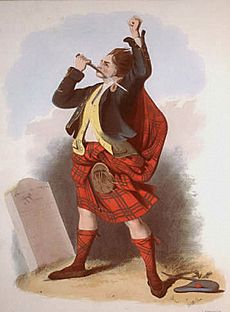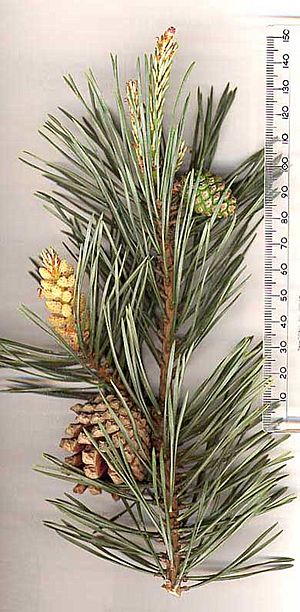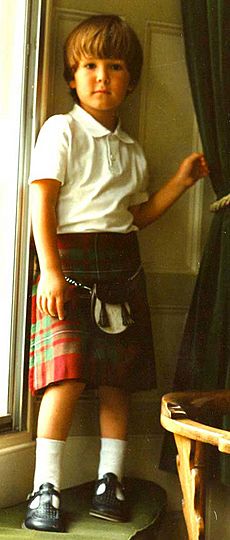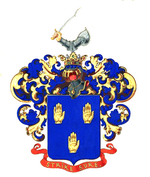Clan Gregor facts for kids
Quick facts for kids Clan Gregor |
|||
|---|---|---|---|
| Clann Ghriogair, na Griogalaich | |||
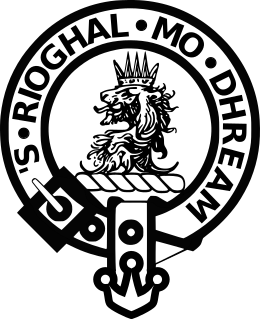
Crest: a lion's head erased Proper, crowned with an antique crown Or.
|
|||
| Motto | 'S Rioghal mo dhream (Royal is my race) | ||
| War cry | Àrd-Choille | ||
| Profile | |||
| Region | Highland | ||
| District | Argyll, Perthshire Highlands | ||
| Plant badge | Scots Pine | ||
| Pipe music | Ruaig Ghlinne Freoine | ||
| Chief | |||
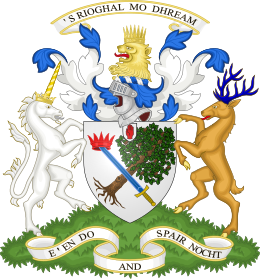 |
|||
| Sir Malcolm MacGregor of MacGregor | |||
| The 7th baronet of Lanrick and Balquhidder (An t-Ailpeineach Mòr) | |||
| Seat | Boreland House | ||
|
|||
|
|||
|
|||
Clan Gregor, also known as Clan MacGregor, is a famous Highland Scottish clan. A clan is like a large family group with a shared history and leader. This clan believes its story began very early, around the 800s.
One of the most well-known members of Clan Gregor was Rob Roy MacGregor. He lived in the late 1600s and early 1700s. The Clan Gregor was also one of the first families in Scotland to start playing the bagpipes in the early 1600s.
Contents
History of Clan Gregor
Where the Clan Came From
The MacGregor clan used to own lands in areas like Glen Orchy and Glenstrae. Some historians believe the MacGregors came from an old Celtic royal family. This idea is even hinted at in the clan's motto: "Royal is my race."
There's also a story that Gregor, the clan's founder, was the brother of Kenneth MacAlpin. Kenneth was an early king of Alba, which was an old name for Scotland. While there isn't much proof, some historians support this idea. The first known chief of Clan Gregor was Gregor, who was called "of the golden bridles." His son, Iain Camm "One eye," became the second chief before 1390.
Over time, much of the MacGregor land was given to the chief of Clan Campbell. The Campbells built Kilchurn Castle, which controlled important routes. This pushed the MacGregors further into their own lands.
Challenges in the 1500s
In 1519, the chief Iain of Glenstrae passed away without direct children. The Campbells helped his relative, Eian, become the next chief. Eian even married a daughter of a Campbell leader. In 1547, Eian's son, Alistair, fought bravely against the English in a battle but died soon after.
Another MacGregor, Gregor Roy, tried to claim the family lands. For ten years, he fought against the Campbells. He was an outlaw, meaning he lived outside the law, often raiding cattle and hiding in the high glens. Sadly, in 1570, the Campbells captured and killed him. His son, Alistair, became chief but couldn't stop the Campbells from harming his family. Because of their many losses, the MacGregors became known as the Children of the Mist.
Around this time, a man named John Drummond, from Clan Drummond, was killed. He was the king's forester and had hanged some MacGregors for hunting illegally. The MacGregor chief took responsibility for the killing, and the king's council was very angry about it.
Conflicts and Civil War in the 1600s
In 1603, two MacGregor clansmen were executed. In response, Alasdair MacGregor led over 400 men into the lands of Clan Colquhoun. The Colquhoun chief had permission from the king to stop the MacGregors. He gathered 800 men and marched to Glen Fruin to fight them.
MacGregor divided his force. While one part fought the Colquhouns head-on, the other attacked from behind. The Colquhouns were pushed into a swampy area where their horsemen couldn't fight well. Over 200 Colquhouns were killed. Many years later, in a sign of peace, the chiefs of both clans met at the battle site and shook hands.
In April 1603, King James VI of Scotland made a law that said the name MacGregor was "completely abolished." This meant anyone with the name had to change it or face death. In 1604, MacGregor and eleven of his leaders were hanged in Edinburgh. The Clan Gregor was scattered, and many had to take new names like Murray or Grant. They were hunted down, even with bloodhounds.
A person from Edinburgh who kept a diary wrote about it:
MacGregor was taken to Berwick by the Guard, as the Earl promised to put him out of Scottish ground. So he kept a Highland-man's promise: he sent the Guard to take him out of Scottish ground, but they were told to bring him back! On January 18th, in the evening, he came back to Edinburgh. On the 20th, he was hanged at the Cross, along with eleven of his friends and family, on a gallows. As the Chief, he was hanged higher than the rest of his friends.
A law from 1617 said that the name MacGregor should be removed. It stated that anyone with the name must change it, and their children and future family should never use "Gregor" or "MacGregor." If they did, they would face death.
Despite this harsh treatment, the MacGregors still fought for the king during the Scottish Civil War. About 200 MacGregor men fought for the Earl of Glencairn against the government. Because of this, King Charles II of England allowed the name to be used again. But when a new king, William of Orange, took over, the ban on the name was put back in place.
The 1700s and Jacobite Risings

Rob Roy MacGregor was born in 1671. Because of the laws against his clan, he had to use his mother's last name, Campbell. His adventures have been made famous in a novel called Rob Roy by Sir Walter Scott. Rob Roy caused a lot of trouble for the government until he died in 1734. He supported the Jacobites, who wanted to bring back the old royal family. After a battle in 1715, he started raiding and taking things. He even led Clan Gregor in another battle in 1719. He is buried in Balquhidder churchyard.
During the 1745 uprising, some MacGregors fought in a battle with the Jacobite army. Some were also part of a Jacobite group that was defeated in 1746. This meant they missed the big Battle of Culloden the next day. After the uprising, as the MacGregors returned home, no one dared to stop them. They marched proudly, even past a castle where enemy soldiers "dared not move."
The unfair treatment of the MacGregors finally ended in 1774 when the laws against them were removed.
The Clan Restored in the 1800s
To bring back pride in the clan, a new chief was needed. Many MacGregors signed a petition saying that General John Murray of Lanrick was the true chief. He was a MacGregor descendant. His son, Sir Evan, played an important role when King George IV visited Scotland in 1822. Sir Evan and his clansmen had the great honor of guarding the Honours of Scotland. These are the Scottish crown jewels, the oldest set in the British Isles.
Clan Chief
The current chief of Clan Gregor is Sir Malcolm Gregor Charles MacGregor of MacGregor. He is the 7th Baronet of Lanrick and Balquhidder and the 24th Chief of Clan Gregor. His Gaelic title, An t-Ailpeanach, shows the clan's traditional link to an old royal family line called Siol Alpin.
Clan Symbols
- Crest badge: Clan Gregor members can wear a crest badge. It shows a lion's head wearing an old crown. Below it is the clan's motto in Scottish Gaelic: 's rìoghail mo dhream. This means "Royal is my race."
- Plant badge: The special plant for Clan Gregor is the Scots pine.
Signet and Seal in Iowa
Some family members of Rob Roy MacGregor moved to America and settled near McGregor, Iowa. In 1849, it was said that the original MacGregor seal and ring were owned by Alex McGregor in Iowa. The clan seal had a Gaelic message that was understood to mean "I am of royal descent/Slay and spare not." The ring had a special stone from Loch Lomond.
Clan Tartans
Many different tartan patterns are linked to the name MacGregor. However, the current chief of Clan Gregor officially recognizes only the following as "clan tartans":
| Tartan image | Notes |
|---|---|
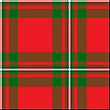 |
MacGregor Red and Green. This tartan was recorded around 1810–1820. It was first called "MacGregor Murray Tartan" and later simply "MacGregor." |
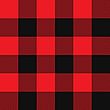 |
MacGregor Red and Black, also known as Rob Roy MacGregor. This is a very old tartan pattern. It is sometimes called "buffalo plaid" in the US. The clan chief says that any MacGregor can wear this tartan. |
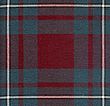 |
MacGregor of Cardney. This tartan was created around 1930 by Alasdair MacGregor of Cardney. He was the younger brother of a past chief. It's a version of the Red and Green tartan. While it was made for the MacGregors of Cardney, they are happy for other MacGregors to wear it too. |
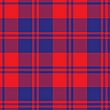 |
MacGregor of Glengyle, also known as MacGregor of Deeside. This tartan dates back to about 1750. The clan chief says that members of the Glengyle branch of the clan, or MacGregors from Deeside, can wear this tartan. |
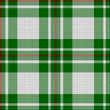 |
MacGregor Green. This tartan is mainly for dancing. The chief has approved it only for Highland dancers who compete. MacGregors who are not Highland dancers should not wear this tartan. |
Clan Septs (Related Names)
The Clan Gregor Society lists many names that are connected to the clan. If you have one of these last names, or if your mother had one, you might be able to join the society. Different spellings like M', Mc, and Mac are considered the same.
- Alpin
- Fletcher
- Greer
- Gregg
- Graig
- Gregor
- Gregorson
- Gregory
- Gregson
- Greig
- Grewer
- Grier
- Grierson
- Grigg(s)
- Grigor
- Gruer
- Hubberd
- King
- Lawrence
- MacAdam
- Macaldowie || Macara ||Macaree || MacChoiter
- McGehee
- MacConachie
- MacCrowther
- MacEan
- MacEwin
- MacGregor
- MacGrigor
- MacGrowther
- MacGruder
- Macilduy
- MacLeister
- MacLiver
- MacNee
- MacNeice
- MacNeish
- MacNie
- MacPeter(s)
- MacPetrie
- Magruder
- Malloch
- Neish
- Patullo/Pittillow
- Peter
- Petrie
- Gragg
Some names were used by MacGregors when their own name was banned. If you can show a family link to a MacGregor, you might be able to join.
- Bain
- Beachley
- Black
- Bowers
- Bowie
- Coleman
- Comrie
- Dochart
- Dunn
- Lakie
- Lakey
- Landless
- Lawrence
- Leckie
- Lockie
- Mor
- Roy
- Skinner
- White
- Whyte
- Willox
Other names are traditionally linked to MacGregor, but there's less proof. If you have a family story or evidence of a MacGregor connection, you can inquire about membership.
- Argyl
- Arrowsmith
- Begland
- Brewer
- Caird
- Callander
- Clark
- Craigdallie
- Crerar
- Crowther
- Denison
- Docherty
- Dorward
- Dowie
- Fisher
- Gair
- Goodsir
- Grayson
- Gudger
- Guinness
- Kirkwood
- Leishman
- MacAndrew
- MacAngus
- MacCanish
- MacGeach
- Macgehee
- Macghee
- MacGill
- MacGrew
- Macnocaird
- Macnucator
- Nelson
- Neilson
- Nucator
- Orr
- Paterson
- Peat
- Peet
- Peterson
- Shankland
- Stringer
- Tainsh
- Telfer
- Telford
- Tossach
- Walker
- Weliver
Finally, some names belong to other clans but were sometimes used by MacGregors. If you have one of these names and can show a link to a MacGregor who used it as an alias, the Clan Gregor clan welcomes your inquiry.
- Balfour
- Buchannan
- Campbell
- Cunningham
- Donald
- Dougal
- Douglas
- Drummond
- Erskine
- Ferguson
- Gordon
- Graham
- Grant
- Hay
- Johnson
- Johnston
- Livingston
- MacAlastair
- MacDonald
- MacDougal
- MacEwan
- MacFarlane
- MacIan
- MacInnes
- MacLaren
- MacNeil
- MacNicol
- MacPherson
- Menzies
- Murray
- Ramsay
- Stewart
- Stirling
- Williams
- Wilson
See also
- Siol Alpin: Other clans that are thought to be related to the same ancient royal line as Clan Gregor.
- Greig (Russian nobility): A noble family in Russia that has Scottish roots from this clan.
- Edvard Grieg: A famous Norwegian composer who was a descendant of the clan.
- Greigia: A type of plant named after Samuel Greig, a member of the clan, in 1864.
- Tulipa greigii: A type of tulip named after Samuel Greig because he was president of the Russian Horticultural Society.
- Niau: An island in French Polynesia, named Greig after Aleksey Greig, a Russian admiral with clan ties, in 1820.



